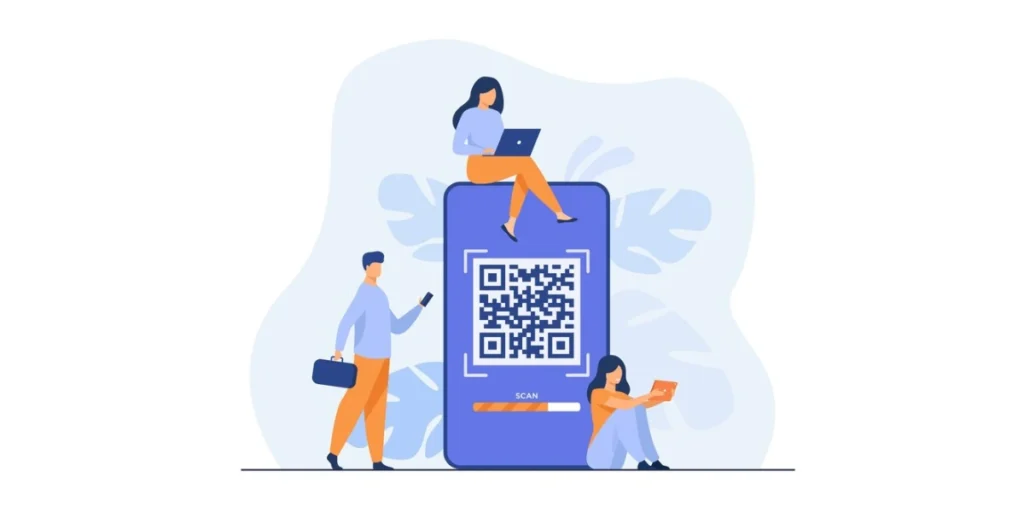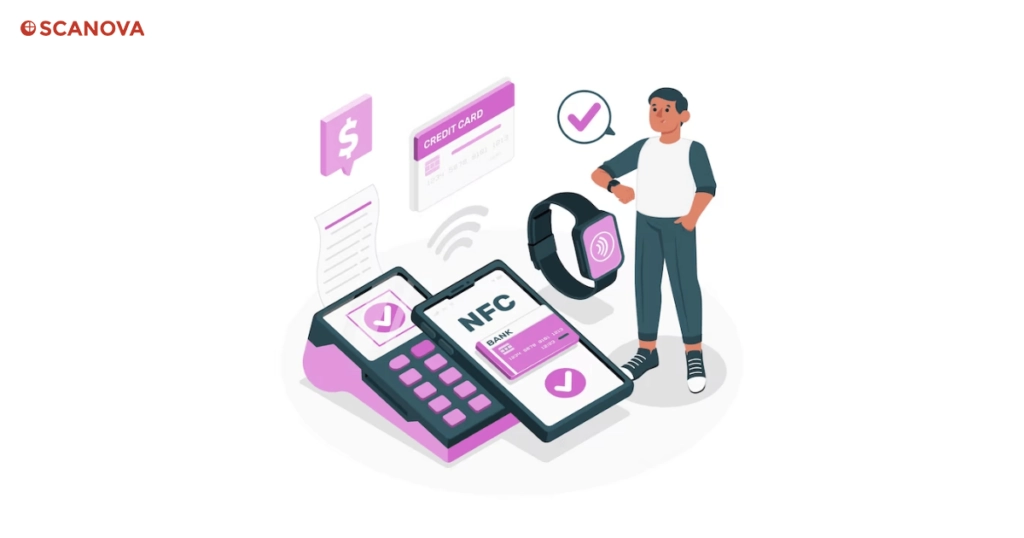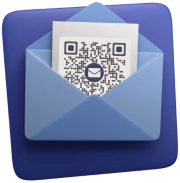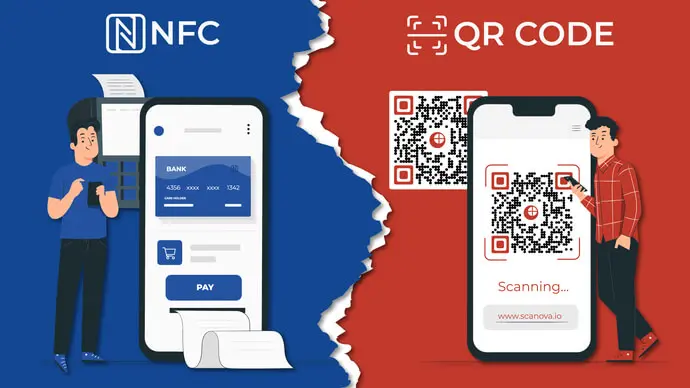Today, the most important thing for businesses is the customer experience. Experts believe customer experience is the primary factor that influences buying decisions.
Two popular technologies that have come to the forefront in optimizing customer experience are QR Codes and NFC tags.
And that makes sense! Because what’s the most convenient way to engage customers who spend most of their time on a smartphone? Their phones, right?
But when it comes to QR Code vs NFC, which is the better option? In this article, we’ll dive into the uses, advantages, and key differences between the two.
Let’s begin!
A. What is a QR Code?

A QR Code is a kind of an advanced barcode (2D) that stores data. This data could be anything from texts, URLs, and contact information, to other multimedia.
QR Codes can be scanned through a smartphone camera, and they usually prompt the users to take action. These actions range from opening a certain website, opening a payment link, or downloading an app.
QR Codes are great for digital marketing, payments, and thousands of other use cases because of their versatility and ease of use.
1. Common uses of QR Codes
1. QR Codes for marketing and promotions: Many businesses put QR Codes on their ads, flyers, and posters.
This could be to offer users discount coupons or details of the product. Users can immediately access this information by scanning the QR rather than typing long URLs.
In case you want to know how to use QR Codes for marketing purposes, here is a quick guide to get you started.
2. QR Codes for payments: QR Codes are also a commonly used payment technology.
Apps like Paytm, GooglePay, Venmo, and PayPal, all use QR Codes for payments. QR Codes enable fast and secure transactions without needing cash or cards.
3. QR Codes for event check-ins: Most event/concert tickets these days have QR Codes on them.
They ensure fast check-ins at events, so the guests do not have to waste any time waiting in long queues.
4. QR Codes in Education: More and more teachers and institutions now use QR Codes to share digital resources, quizzes, or even video tutorials with the students. It is a very modern way to teach.
5. QR Codes for asset tracking: Companies put special QR Codes on inventory items. This makes it easier and faster to track it by scanning.
Did you know that QR Codes (developed by Denso) were initially used to track car parts in Japan’s automotive industry?
2. Benefits of using QR Codes
1. Accessibility everywhere: QR Codes are universal. Anyone with a smartphone can read a QR Code. So there’s rarely a need for any special equipment or applications.
Studies show that 85% of consumers have scanned a QR Code at least once. They’re a staple in menus, product packaging, and promotions.
2. Low cost: Be it a small business or a big enterprise, generating and printing QR Codes helps you save costs.
All you need is a reliable QR Code generator with affordable plans, and you are good to go.
3. Customization options: QR Codes don’t always have to be black and white. You can match the colors of the QR Code to better suit your theme or brand.
You can even add your logo, or use unique frames to make them more visually appealing.
4. Flexibility: Whether you’re creating a single QR Code for a personal project or going for thousands of them for a large marketing campaign, QR Codes can scale to meet your needs seamlessly.
5. Trackability: Have you ever wondered, “Can you track QR Codes?” Well, the answer is yes!
Dynamic QR Codes let you track data like scan time, location, and the type of device used while scanning.
These insights are really valuable for businesses to better optimize their future campaigns.
B. What is NFC?

NFC (Near Field Communication) technology is a wireless communication tech that enables data exchange between devices.
It works for devices that are within a short range (typically 4 cm or less). It is often embedded in NFC tags or NFC cards or other NFC-enabled devices.
1. Common uses of NFC
1. NFC contactless payments: NFC tech enables users to make contactless transactions through NFC tech. Think of apps like Apple Pay or Google Pay or tap cards.
NFC tags dominate payment systems like contactless cards, but outside this domain, their use is limited.
2. Access control: ID badges or access cards with NFC tags are often used in offices for entry/exit.
3. Smart advertising: NFC tags in posters let users tap their phones to access information. This information could be anything.
From a simple redirection to a website to information about the artwork, NFC tags make advertising smarter.
4. Product authentication: NFC tags help verify the authenticity of high-value goods.
NFC tags are often considered a foolproof method for checking the authenticity of a product.
2. Advantages of using NFC tags
1. Convenience: With NFC technology, you don’t even need to open a camera or app; just tap your NFC-enabled device, and it will be a smooth journey.
2. Secure communication: In the case of NFC tags, since the data exchanged is encrypted, the communication remains secure.
This makes NFC cards ideal for payments and authentication purposes.
3. Durability: NFC tags are usually embedded in physical objects, and hence, they can withstand wear and tear easily.
4. Interactive experience: NFC technology adds an immersive element to marketing campaigns.
This makes the user experience tech-savvy and modern, which keeps the audience engaged.
Now that you’ve understood what both technologies are, let’s see the difference between NFC and QR Code technology.
C. 5 Differences between QR Codes and NFCs
1. Ease of accessibility
While many new smartphones come with inbuilt NFC tags, many old ones lack them. If your phone doesn’t have one, it is impossible to use NFC.
On the other hand, most smartphones today come with an in-built QR Code scanner. In fact, some phones that don’t have that can still install free third-party QR Code scanning apps.
You just have to open the app and hold it in front of the QR Code. You will receive a pop-up notifying you that the QR Code has been scanned.
2. Distance and contactless capabilities
NFC technology works for a radius of a mere 4 cm (1.5 in). Also, NFC tags work only when they come in direct contact with another NFC-enabled device.
But here’s the problem ever since the pandemic, people prefer contactless alternatives. To use NFC tech, both devices need to directly touch each other.
On the other hand, QR Codes can easily overcome this challenge because they can be scanned from a distance.
The best part is that they can be scanned even from far away distances. (provided the size and quality of the image is good)
The suitable QR Code size depends on its distance from the scanner. For example, a QR Code that’s 2cm X 2cm in size won’t be scannable from 100 cm away.
Sounds fair, right? But you cannot rely on guesstimates all the time. So, for your convenience, you can calculate the right size of the QR Code using a basic rule.
Rule of thumb: The ratio of scanning distance to the QR Code’s size should be close to 10:1. This means that if a QR Code is to be scanned from a distance of 100 cm, it must be at least 10 cm wide.
3. Hassle-free data sharing
NFC is not a universal technology. As mentioned above, not all devices have NFC technology. But that’s just the half-truth.
The other half is that NFC has problems with sharing files. For example, let’s say you are trying to share files in different formats with someone. Here, both of you have different smartphones.
In this case, there is a probability of facing issues with file-sharing. Moreover, when phones get new OS updates, NFC functionality gets affected.
Hence, you can say the NFC doesn’t offer a universal and convenient information transfer. But QR Codes are different. Invented ahead of NFC, they are quite universal in nature. How?
Well, first, you don’t need any special device to scan QR Codes. All smartphones can scan QR Codes (whether it’s through the native camera or a third-party app).
Secondly, scanning the QR Code will fetch the same content irrespective of the device, OS, or browser. Great, right?
4. Data and cyber security
Cyber attacks have become a menace in this tech-driven world. So, it becomes important to use technologies that provide cyber resilience for both you and your customers.
In this context, NFC tech often faces major security issues such as:
- Eavesdropping: Under it, criminals can intercept the signal between two devices. They can use it to steal private data.
- Data corruption or manipulation: Data transferred during an NFC transaction can be corrupted or manipulated. This is done so that the receiver can’t use it.
- Interception attacks: In this attack, an NFC data transfer is rerouted to a tool that it wasn’t intended for. Here, someone can act as a middleman between two NFC devices. They can then receive and alter the data to be shared between the two devices.
However, with QR Codes, this worry goes out of the window. How? Well, QR Codes are way more secure than NFC. There is no chance of eavesdropping, data manipulation, or interception attacks.
Why? Because a person scanning a QR Code controls how and when they view the content, hence, you don’t need to worry about anything.
5. Offline to online (O2O) transitions
NFCs can only work with two electronic devices with NFC tags. QR Codes, on the other hand, can work via both print and digital channels.
You can print QR Codes on newspapers, billboards, and magazines. Customers can scan them to view the encoded content digitally.
QR Codes act as a bridge between offline and online media. That’s why many marketers use them to make the most of their print media campaigns.
D. QR Code vs NFC Tags: A direct comparison
| Feature | QR Code | NFC Tags |
|---|---|---|
| Accessibility | Scannable by any smartphone camera | Works only on NFC-enabled devices |
| Cost | Free to generate; Plus you can save on printing costs | Higher cost for tags |
| Ease of Use | All you need is a smartphone camera or scanning app | Need both devices to tap to interact |
| Customization | Fully customizable | Limited to basic designs |
| Distance | Scannable up to a few feet | Limited to 4 cm or less |
| Trackability | Yes, dynamic QR Codes can track data | Limited tracking functionality |
| Adoption Rate | Widely adopted globally | Slower adoption due to costs |
When comparing NFC vs QR Code, QR Codes often emerge as the better option because of the following reasons:
1. Cost-Effectiveness: QR Codes are often free to generate (atleast static QR Codes are), whereas NFC tags involve high manufacturing costs.
2. Wider compatibility: Most smartphones can scan QR Codes without additional apps (even if your device can’t, you can simply download a free third-party app to do the job), whereas not all phones support NFC tech, so that’s a bummer.
3. Better Reach: QR Codes can be printed on everything from flyers to billboards hence, they’re quite accessible (even from a distance)
4. Higher Adoption: According to recent stats, QR Codes have a global adoption rate of over 60%, while NFC tags lag behind at around 20%.
Pro Tip: Generating a QR Code is virtually free, while NFC tags can cost between $0.20 and $0.50 each. This makes QR Codes the obvious choice for budget-friendly projects.
Now that you know QR Codes are better than NFC tech in so many ways, let’s see how you can create your own QR Codes. Keep reading!
F. How to create QR Codes?
If you’d like to get started with QR Codes, you’ll need to know how to create them. Well, there are multiple ways to do it. Here’s how:
1. Create QR Codes one by one
If your use case doesn’t require hundreds (or thousands) of QR Codes, this is your way to go. You just need a QR Code generator to get started.
A reliable QR Code generator will give you various QR Code categories to choose from. For example, document QR Code, website URL QR Code, Vcard QR Code, etc.
Here, you can create both static and dynamic QR Codes. To get started, you simply have to follow this step-by-step guide.
2. Create QR Codes in bulk
If you need hundreds or thousands of QR Codes, then go for this option.
Here, a bulk QR Code generation service such as QR Batch will make your work easy. It will help you create up to 100,000 static QR Codes in one go.
To generate them, you just must upload a file with the data that is to be encoded in the QR Codes in XLX, CSV, or XLSX formats. For more information, you can check out this detailed guide.
And, if you want to generate dynamic QR Codes in bulk, you can refer to this guide on how to do it.
3. Create QR Codes programmatically
Say you want to integrate QR Code generation into your own system. Then, QR Code API can help you out.
It allows you to create static QR Codes programmatically in real time. Hence, there’s no manual work involved in creating QR Codes.


G. FAQs: QR Code vs NFC tech
1. What does NFC stand for?
NFC stands for Near Field Communication. It is a short-range wireless technology.
2. Can you track NFC tags?
Tracking NFC tags is possible but it is limited. You need specific software and hardware to monitor tag interactions. QR Codes are better in this aspect.
3. Can you track QR Codes?
Yes! Dynamic QR Codes allow tracking of scans, providing data like time, location, and device type. This feature is limited in case of NFC technology.
4. What’s the key difference between a QR Code and NFC?
The primary difference between QR Code and NFC lies in their accessibility. QR Codes work with any smartphone camera, while NFC works only on NFC compatible devices.
5. Which is better for marketing: QR Code or NFC?
For most campaigns, QR Codes are better because of their affordability, reach, and ease of use.
However, NFC tags offer a premium experience for high-end products.
Final thoughts: QR Code vs NFC
When it comes to QR Code vs NFC Tag, the choice depends on your needs.
If you want a cost-effective, versatile, and widely accessible solution, QR Codes are the way to go.
But for specific applications like secure payments or authentication, NFC tags might be worth considering.
If you’re still reading, you’ve learned everything about QR Code Vs NFC. You can now make an informed decision before getting started with either of the two for your use case.
Looking to create trackable, custom QR Codes for your next project? Start now with Scanova and enjoy a seamless experience!


